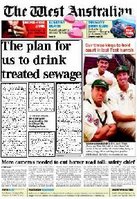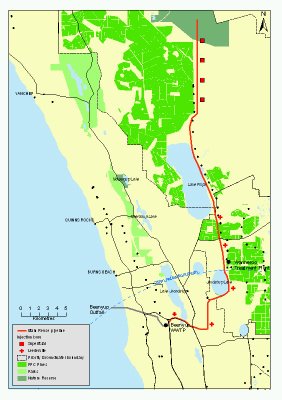Approximately 60% of the water supplied to Perth is sourced from groundwater. Sandy areas or porous rocks which contain significant amounts of underground water are called aquifers. In some locations there can be numerous aquifers at different depths separated by impervious rock. The upper-most aquifer is known as the ‘shallow aquifer’ or ‘unconfined aquifer’ and its upper surface is the water table.
The water table tends to follow the topography of the ground surface, -rising where the ground gets higher and dropping in lower areas. As a result, groundwater ‘mounds’ tend to develop in comparatively higher areas. Where this happens, there is a slow horizontal flow of water outwards from the mounds under the influence of gravity. The horizontal flow rate is typically only 10 to 100 metres per year.
The city of Perth sits on what is known as the Swan Coastal Plain. The unconfined aquifer directly below it is known as the Superficial aquifer and is on average about 50 metres thick. The Superficial aquifer has two important mounds. These are the Gnangara mound to the north of Perth and the smaller Jandkot mound to the south. Below the Superficial aquifer there are a number of confined aquifers, the largest of which are the Leederville, which is typically several hundred metres thick, and the Yarragadee, which in many areas is more than a kilometre thick.
The Leederville aquifer is an important drinking-water source for Perth. The Superficial aquifer has also been an important water source for many decades and it is very common for Perth households to extract water directly from it for garden and lawn watering. The exploitation of this groundwater is rapidly approaching sustainable limits in some areas, causing the water table to drop markedly.
Managed aquifer recharge refers to the process of adding a water source such as recycled water to depleted aquifers under controlled conditions. Water can be added to an unconfined aquifer by passive infiltration from a pond (or ‘basin’) or by pumping it along a shallow pervious pipe or gravel trench known as an infiltration gallery. In either case, the water infiltrates down through the soil to the aquifer. Recharging a confined aquifer normally requires pressurised pumping through an injection well.
The organisation that manages Perth’s water resources is Water Corporation. They have signalled that they see managed aquifer recharge as a means of potentially supplying around 27 gigalitres per year of public drinking water injected via the Gnangara mound by 2015. The source water would be advanced-treated recycled water from Beenyup Wastewater Treatment Plant. It would then be transported via a (roughly 40 km) pipeline to a nature reserve further north of Perth. At various points en route, water would be injected into the confined Leederville aquifer or infiltrated into the Superficial aquifer.
The image below is a conceptual diagram of such a scheme showing a recycled water pipeline from Beenyup. The red crosses show possible injection points for the Leederville aquifer and the red squares show possible infiltration sites for the Superficial aquifer. Click on the image and magnify it for a better view.
However, before committing to the hundreds of millions of dollars needed to build such as scheme, Water Corporation have elected to begin by the construction of a smaller trial, through which annually 1.5 gigalitres of recycled water would be injected into the Leederville aquifer at Beenyup. Before injection, the treated effluents would be upgraded to potable standard by advanced treatment including microfiltration, reverse osmosis, and advanced oxidation (probably UV). The water will then be injected to a depth of around 200 metres. Water Corporation have predicted that this water would then take a minimum of 50 years before reaching drinking-water production bores more than three kilometres away.
Detailed monitoring of water quality will be undertaken prior to injection into the aquifer and also via a number of extraction wells as the water moves horizontally away from the Gnangara mound. The monitoring program is intended to be undertaken over a period of three years.
 As well as demonstrating the technical feasibility, an important aspect of the trial project is to enhance community confidence in potable recycling by managed aquifer recharge. This week, the West Australian newspaper ran a front page story with the large-font headline 'The plan for us to drink treated sewage' (Warnie doesn’t look too impressed with the idea!). Personally, if I were the paper’s editor, I would have left out the word 'treated' for an even more alarmist headline. But more importantly, the accompanying article did give a good description of the proposed scheme and the role that it is expected to play as a component of future water supplies. As we have all seen, communication and the provision of accurate information to the community must be key components of planning for potable water recycling schemes.
As well as demonstrating the technical feasibility, an important aspect of the trial project is to enhance community confidence in potable recycling by managed aquifer recharge. This week, the West Australian newspaper ran a front page story with the large-font headline 'The plan for us to drink treated sewage' (Warnie doesn’t look too impressed with the idea!). Personally, if I were the paper’s editor, I would have left out the word 'treated' for an even more alarmist headline. But more importantly, the accompanying article did give a good description of the proposed scheme and the role that it is expected to play as a component of future water supplies. As we have all seen, communication and the provision of accurate information to the community must be key components of planning for potable water recycling schemes.I think this is an exciting trial which heralds a new dimension to sustainable water management in Australia. What do you think?


15 comments:
"communication and the provision of accurate information to the community must be key components of planning for potable water recycling scheme"
Do you think Beattie and the QWC are engaging in proper communication or is the SEQ poll just a repeat of the debacle in Toowoomba?
WA's strategy seems more sensible at the moment.
You forgot to mention that Perth now has one of the largest desalination plants in the world.
G'day Desal Boy,
I think Beattie's off to a reasonable start, but certainly much more information will be required by the community before they can make an informed decision in March. I am aware of a couple of major documents that are currently under preparation.
I mentioned that Perth now has one of the largest desalination plants in the world in the post I wrote on seawater desalination. The current post is about managed aquifer recharge.
Can you really change people's perceptions in just two months - it didn't work in Toowoomba and they had over a year to do so.
Why put a deadline like a poll date on trying to determine whether you have successfully 'communicated' with your audience?
I tend to agree with you. Two or three months is a very very short amount of time and the opportunity has been there for Beattie to vocally support the concept of planned potable recycling for much longer (eg. during the Toowoomba campaign). I don't claim to always understand politicians.
Beattie was actually quoted during the Toowoomba debate on the evening news saying: "we're doing an experiment in Toowoomba but I wouldn't drink it".
Hardly a poster boy for the recycled water cause.
The WA approach with its studies over the next few years seems sensible. Can't help wondering about Beattie's approach to put the recycled water into Wivenhoe as soon as the pipeline is built. Even Singapore had several years of testing.
After looking at this document I do not believe they are planning on using this aquifer for drinking water. I believe it is more a plan to prevent seawater intrusion of the aquifers on the Swan coastal plain and at the same time provide a secure water supply for industry and parks and gardens!
Thanks Greg,
Prevention of seawater intrusion to the aquifers and providing water for parks, gardens and industry (much of which comes directly from the Superficial aquifer) are certainly very important components of the scheme. However, since around 60% of the city’s potable supplies also come groundwater (with the Gnangara Mound being among the most important sources), it is inevitable that this will be an indirect potable water recycling scheme, regardless of whether anyone chooses to notice it or not. The West Australian newspaper really didn’t make it up themselves.
Well I cannot find any info that would lead me to believe that they are going to use this aquifer to supply people with drinking water. Perhaps you could find some for me Stuart! I believe the newspaper in question was just trying to boost sales with a dramatic story! It happened many times here in Toowoomba during the water futures finasco! I believe Perth will start drawing there drinking water form desal and recharge the aquifers they do not use for drinking water by putting recycled effluent back into them so there is less effluent pumped into the ocean. Trying to make people drink it would be bad economic planning!
G’day Greg,
I’ll keep an eye out for something from WA that explicitly says the words ‘indirect potable reuse’. If I spot something, I’ll let you know. However, I do like your theory: taking drinking water from the ocean and discharging waste to aquifers…a nice reversal of the traditional municipal water cycle.
Well Stuart, that is exactly what will be happening. Water that was recently seawater could become groundwater in just a day or two.
Think of the money they could save simply by reversing the flow of water through their sewage disposal system and their drinking water distribution system ;-)
I would rather eat Heinz baked beans then Home Brand. Sometimes the consumer is who needs to be considered, not the costs! Perth is implementing a means to supply its people which much more palatable domestic water and can use utilize the unpalatable water for non consumption and at the same time help the local environment! Makes perfect sense to me! There is no need for them to follow the other path!
Thanks Greg,
I don’t doubt the ability of a refined palate to distinguish between Heinz and Home Brand baked beans. But...I do want you to be sure that I was only joking about my cost-saving suggestion.
Yeah, lets just use up all our aquifers, run then dry so there's nothing left.
Are we all as stupid as the Toowoomba City Council: See Here.
C’mon, we have level water restrictions and the council simply poor our bore water down the drain, something us rate payers would get a fine for. That water is perfect for drinking, much safer the potalble reuse.
If Perth is thinking of taking up potable reuse, pity help them. I don't see why recycled water needs to be put back into drinking supplies... For f/sake, simply create a small dam, dump it there, and if anything goes wrong, turn it off, keeping the drinking dams safe.
If potable reuse is SO SAFE, do it this way first to prove it, then maybe people may not be so optimistic,, I for one will not drink it unless it was the only water left on earth.
recycled water is the future.
people just need to get over it. The government will ensure that its safe.
we are already drinking a small amount of recycled water anyway...
but it your that antsy about recycled water just install a water filter system in your house and be done with it!
Post a Comment